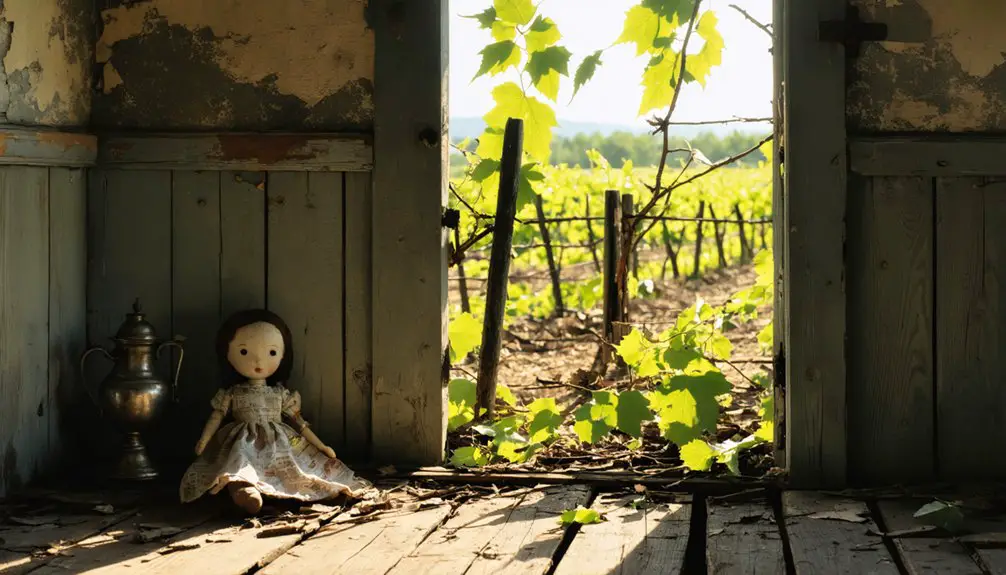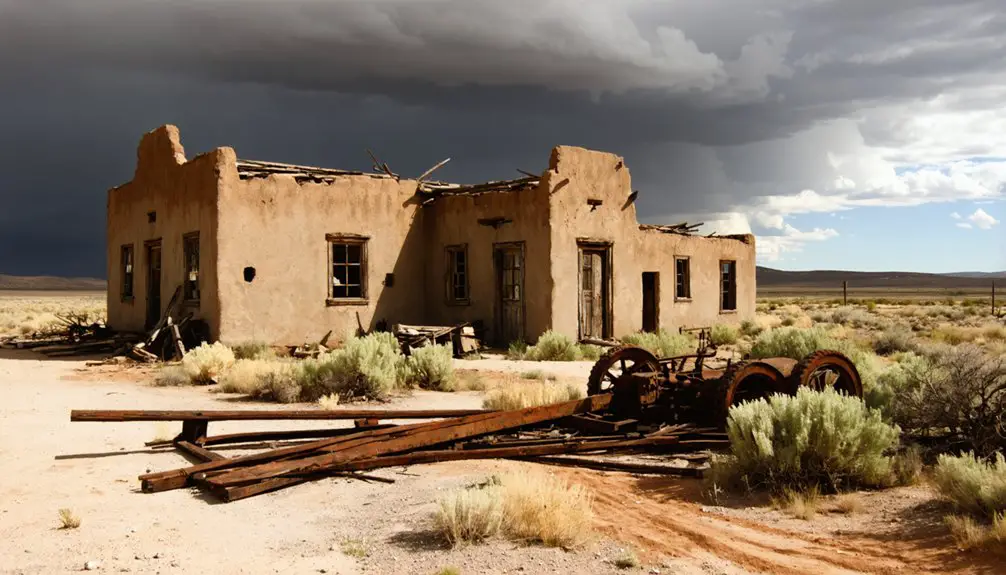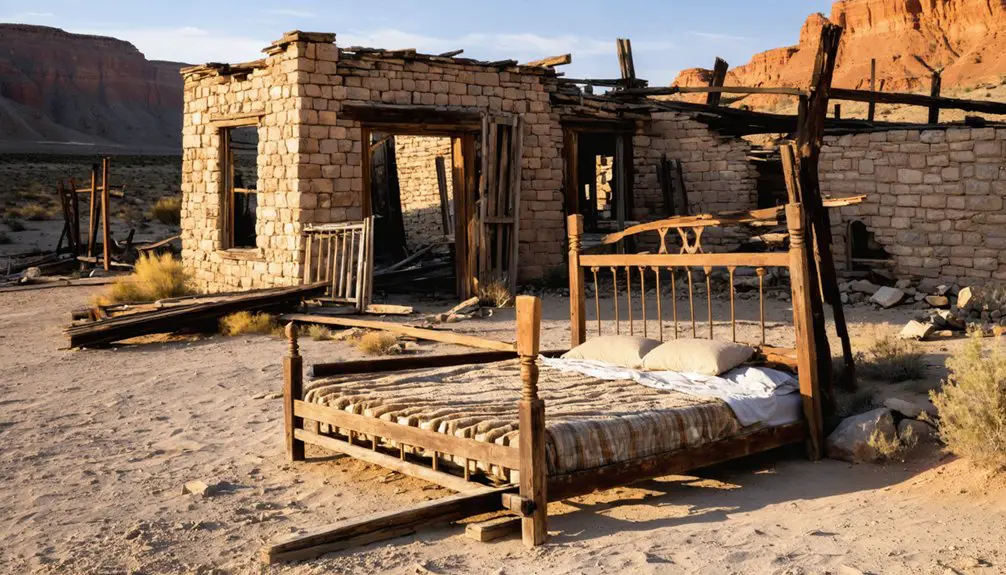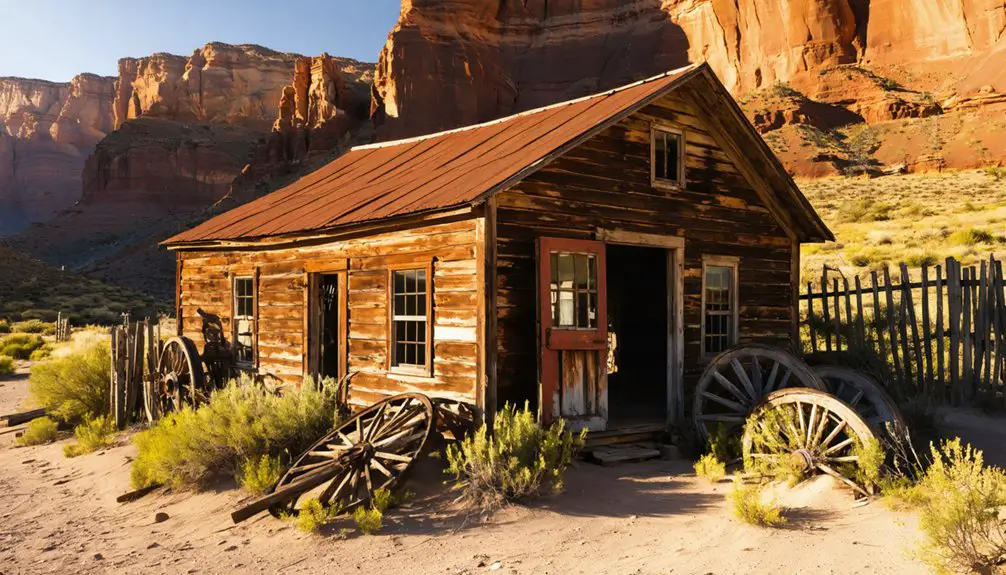You’ll find the remnants of a fascinating Russian religious settlement near Russian Knoll in Box Elder County, Utah. In 1914, about 100 Molokan Spiritual Christians arrived from Los Angeles to establish a traditional farming community, purchasing 10 square miles of land. Despite their determination to preserve their culture through communal living and strict customs, harsh conditions, poor soil, and broken promises led to the settlement’s abandonment by 1918. Today, only a cemetery and building foundations reveal this brief cultural experiment.
Key Takeaways
- Russian Settlement was established in 1914 by 100 Molokan Spiritual Christians and Pryguny seeking to preserve their culture in Utah.
- The community purchased 10 square miles in Box Elder County but faced immediate challenges with poor soil and water scarcity.
- Daily life centered around Russian traditions and farming, though most settlers lacked agricultural experience in the harsh Utah environment.
- By 1918, population declined from 100 to 30 families due to crop failures and harsh conditions, leading to complete abandonment.
- Today, only a cemetery, building foundations, and wells remain near Russian Knoll as evidence of this short-lived settlement.
The Vision of a Russian Religious Haven
In 1914, a determined group of roughly 100 Russian religious settlers ventured to establish their vision of a spiritual haven in Box Elder County, Utah.
These Molokan Spiritual Christians and Pryguny sought to escape growing pressures in America that threatened their cultural preservation – from mandatory marriage licenses to government control over education and matrimonial choices.
You’ll find their motivations were deeply rooted in spiritual identity, leading them to purchase around 10 square miles of supposedly fertile land.
They’d envisioned recreating traditional Russian village life, complete with communal farming and strict religious customs. The group of about 20 families from California established what became known as the Russian Settlement.
Similar to the early Mormon settlers, they relied on communal work ethic to survive the challenging environment.
Women maintained conservative dress codes, wearing long dresses and head shawls, while the community preserved their Russian language and customs.
They believed this remote location would shield them from urban modernity and allow them to live according to their religious principles.
A Journey From Los Angeles to Utah
How did these determined Russian settlers make their way from bustling Los Angeles to the remote stretches of Utah? Their road trip would have taken them across nearly 700 miles of diverse landscapes, from coastal plains to high desert terrain.
While today’s travelers enjoy modern conveniences, these pioneers faced a more challenging journey. Modern travelers can opt to take a convenient 3 hour 52 minute flight between the two destinations.
Consider these travel tips that mirror their historic route:
- The primary path follows I-15 through Las Vegas and St. George, taking about 10-12 hours of continuous driving. Today’s journey passes by the majestic Bryce Canyon with its stunning crimson spire formations.
- You’ll cross dramatic elevation changes as you move from sea level to Utah’s mountainous terrain.
- The time zone shift means you’ll lose an hour traveling east from Pacific to Mountain Time.
Like the Russian settlers before you, you’ll witness the landscape transform from urban sprawl to remote wilderness, though your journey will be considerably more comfortable than theirs.
Life in an Isolated Farming Colony
You’d find daily life in the Russian Settlement revolved around strict religious customs, including women’s traditional dress codes and the expectation that families would preserve their cultural heritage through future generations.
The settlers’ attempts at farming were constantly challenged by severe drought, dust storms, and inadequate irrigation systems, made worse by their limited agricultural experience. Most colonists were laborers and tradesmen from urban areas, making their adjustment to farming life particularly difficult.
The tight-knit community structured itself like a traditional Russian village, maintaining social isolation to protect their customs from American governmental interference, particularly regarding marriage and education practices.
Daily Life and Customs
Life in this remote Russian settlement centered around a delicate balance of preserving Molokan traditions while adapting to frontier challenges.
Cultural preservation remained paramount as settlers maintained their Russian language, religious practices, and traditional festivals despite their isolation.
Your daily routine in the settlement would have followed three distinct patterns:
- Morning church gatherings and collective decision-making that formed the community’s spiritual backbone.
- Daytime communal labor with men working the fields while women managed households and preserved food.
- Evening social activities featuring storytelling, religious study, and traditional craft-making.
You’d find comfort in the close-knit extended family networks that supported child-rearing and resource sharing.
The settlement’s design mirrored traditional Russian villages, helping you maintain cultural identity while facing the harsh realities of frontier life. The community of 125 Russian residents struggled to establish themselves after relocating from Los Angeles in search of affordable farmland.
Farming Against Harsh Elements
Despite promises of fertile farmland, settlers quickly discovered the harsh realities of their 2,600-acre purchase, where arid conditions and poor soil quality made large-scale farming nearly impossible.
You’d have seen most families struggling with basic farming techniques, as they’d come from urban backgrounds with little agricultural experience. Only one settler managed to farm their full 80-acre allotment.
The Pacific Land and Water Company’s failed water promises led to devastating crop failures. You couldn’t count on regular irrigation, and the expensive systems you’d invested in often sat useless.
When dust storms weren’t ravaging your fields, you’d battle harsh winters and scorching summers. Your soil quality varied dramatically between plots, forcing most settlers to resort to small garden patches rather than commercial farming – a far cry from the agricultural prosperity you’d been promised.
Community Social Structure
When the Molokan Spiritual Christians arrived in 1914, they established a tight-knit community of roughly 100 settlers patterned after traditional Russian village models.
You’d find social cohesion built around family units and communal practices that shaped every aspect of daily life.
The community’s structure revolved around three core elements:
- Extended family networks that provided essential social and economic support
- Religious gatherings and cultural traditions that united the settlers
- Shared responsibilities for maintaining important resources like wells and tools
Despite their strong social bonds, you couldn’t escape the harsh realities of isolation.
The community’s social fabric began unraveling by 1918 as families faced mounting hardships.
Most settlers returned to California, leaving behind only their cemetery and remnants of a once-vibrant Russian village structure.
The Reality of Broken Promises

The stark reality of broken promises became evident shortly after Russian settlers arrived at their promised utopia.
You’d have witnessed immediate settler disillusionment as they discovered the land agents’ deception – the soil wasn’t fertile, water was scarce, and essential infrastructure didn’t exist.
The agricultural failure that followed was devastating. Instead of the prosperous farmland they’d been promised, settlers faced an arid climate with no irrigation systems or wells.
You can trace how the lack of promised utilities and support systems led to isolation and hardship. The selling company’s failure to deliver basic necessities meant crops withered and hopes died.
Within months, families began abandoning their dreams, with the population dropping from 100 to just 30 families before the settlement’s complete disbandment by 1918.
Daily Customs and Religious Practices
As religious faith shaped every aspect of settler life, you’ll find the Molokan community‘s daily customs deeply intertwined with their spiritual beliefs. Their spiritual practices centered on Bible-focused worship, rejecting Orthodox rituals in favor of simple prayer meetings in homes. Russian remained their primary language for both worship and daily communication.
The settlement’s core meal traditions and daily rhythms followed three distinct patterns:
- Modest, peasant-style meals featuring bread, dairy, and local vegetables brought families together.
- Work ceased completely on the Sabbath, dedicating both Saturday and Sunday to worship.
- Religious education happened at home through Bible reading and memorization.
Through these customs, settlers maintained their cultural identity while adapting to Utah’s frontier conditions, their faith providing strength amid challenging circumstances.
The Struggle Against Nature

Despite their strong faith and communal bonds, Russian settlers faced overwhelming natural obstacles that would ultimately doom their settlement efforts. You can trace their struggle against nature through multiple challenges: the deceptively harsh landscape of dry sagebrush flats, poor soil quality, and scarce water sources made traditional farming nearly impossible.
The land company’s failure to deliver promised irrigation infrastructure left settlers battling nature’s challenges without proper tools or resources. Their survival strategies included attempts to overcome the arid conditions, but environmental degradation from earlier overgrazing and deforestation had already weakened the land’s potential. Like many areas in Utah during the 1800s, unregulated grazing practices had severely damaged the mountain slopes and valley vegetation. The area would later require extensive environmental assessment under federal programs.
Cold winters and minimal rainfall further complicated their farming efforts. By 1917, these combined natural forces, along with financial losses reaching $2,000 per family, forced most settlers to abandon their dreams of establishing a permanent agricultural community.
A Community’s Gradual Departure
As the promised fertile land proved disappointing, you’ll find that crop failures quickly became the reality for these Molokan Russian settlers in 1914.
Despite their determined efforts, the harsh conditions and lack of proper irrigation systems made successful farming impossible, leading many families to abandon their homesteads.
Of the original 30 families who’d stayed after the initial settlement, most eventually returned to California between 1917 and 1918, leaving behind their dreams of establishing a thriving agricultural community.
Failed Crops Drive Exodus
When crop failures struck the Russian Settlement in 1915, they triggered a chain of events that would ultimately lead to the community’s complete abandonment by 1917.
The Pacific Land and Water Company’s promises of fertile soil and abundant water proved devastatingly false, leaving settlers facing severe financial losses between $1,000 to $2,000 per family. The Piute Canal delays severely impacted irrigation capabilities, making successful farming nearly impossible.
The mounting hardships forced families to depart in waves:
- Early crop failures in 1915 drove the first wave of settlers away, as food security became increasingly uncertain.
- By August 1916, the removal of the schoolhouse stove signaled the community’s decline.
- September 1916 saw the complete dismantling of the school, accelerating the exodus.
You’ll find only a small cemetery with two graves marking where these determined settlers once pursued their farming dreams.
Families Return to California
Nearly all Russian Settlement families made their way back to California between 1917-1918, marking the final chapter of their failed rural experiment in Utah.
You’ll find that their return motivations stemmed from harsh realities: poor land quality, lack of promised irrigation, and drought conditions made farming nearly impossible. The Pacific Land and Water Company’s deceptive claims had led these families astray.
The heavy storms and droughts severely impacted their ability to produce sustainable crops during their short tenure in Park Valley.
The migration back wasn’t direct for everyone. Some families temporarily settled in Oregon, Arizona, or Salt Lake City before reaching California.
Cultural preservation remained a priority, with Molokan families choosing northern California while Prygun communities preferred Los Angeles and the southern Central Valley.
Despite the elders’ original concerns about city corruption, economic necessity drew these roughly 100-125 people back to urban areas.
What Remains Today

Today, the Russian Settlement‘s most prominent feature is its cemetery, marked by a white picket fence and containing two notable graves with Russian inscriptions. The graves belong to Anna and Mary Kalpakoff, and descendants installed new headstones in 1966, ensuring cemetery preservation for future generations.
Beyond the cemetery, you’ll find remnants of the abandoned settlement:
- Building foundations and caved-in wells dot the landscape near Russian Knoll at 4,850 feet elevation.
- Artifact discovery continues around the old town lots, which remained identifiable into the 1960s.
- Original structures stood for decades after the 1917-1918 abandonment before succumbing to decay.
No permanent residents have occupied the area since the community disbanded, leaving only these silent witnesses to the settlers’ brief but determined presence.
The Legacy of Russian Knoll
Although the Russian Settlement near Russian Knoll lasted only four years, its legacy endures through both physical landmarks and historical significance.
You’ll find a small fenced cemetery with Russian-language headstones east of Russian Knoll, while eroded house foundations hint at the settlers’ brief but determined attempt at cultural preservation.
The settlement’s story reflects a broader narrative of religious freedom and communal identity in America.
These Spiritual Christians, seeking to maintain their traditions through isolation, exemplify the challenges faced by immigrant communities endeavoring to preserve their heritage.
While their utopian vision didn’t survive Utah’s harsh desert conditions, the settlement’s impact lives on through its named geographical feature on USGS maps and its contribution to understanding early 20th-century religious migration patterns.
Frequently Asked Questions
Did Any Descendants of the Original Settlers Return to Live There?
You won’t find descendant stories of permanent returns – historical preservation records show only cemetery visits by families like the Kalpakoffs, who placed headstones but never resettled the abandoned community.
What Specific Crops Did the Russian Settlers Attempt to Grow?
You’ll find they attempted several crop varieties including wheat, oats, and alfalfa as their main agricultural techniques, with likely attempts at fruits and vegetables based on promoters’ promises and photographs shown.
How Did the Settlers Communicate With Nearby Mormon Communities?
You’ll find that despite settler languages creating barriers, these communities relied on face-to-face meetings, personal letters, and horseback messengers as their primary communication methods when trading or addressing urgent needs.
Were There Any Documented Conflicts Between Different Religious Groups Within Settlement?
You won’t find any documented religious tensions or cultural clashes between the Molokan and Pryguny settlers. Their shared spiritual beliefs and isolated lifestyle kept them unified during their brief Utah stay.
What Happened to the Settlement’s Original Property Deeds and Land Titles?
You’ll find that property ownership likely defaulted when settlers abandoned the land. Most records probably went to Box Elder County or state archives, though land disputes may have voided original claims.
References
- https://en.wikipedia.org/wiki/Russian_Settlement
- https://kids.kiddle.co/Russian_Settlement
- https://www.familysearch.org/en/wiki/Russian_Settlement
- https://www.valleyjournals.com/2024/10/02/507818/exploring-utah-s-ghost-towns-seven-abandoned-settlements-with-fascinating-histories
- https://www.molokane.org/places/USA/Utah/index.html
- https://stories.utahhumanities.org/stories/items/browse?tags=Religion&sort_field=Dublin+Core,Creator&page=2
- https://www.rome2rio.com/s/Los-Angeles/Utah
- https://lazytrips.com/trip/road-trip-from-salt-lake-city-to-los-angeles
- https://www.roadiscalling.com/los-angeles-to-salt-lake-city-drive/
- https://www.airmilescalculator.com/distance/lax-to-slc/



